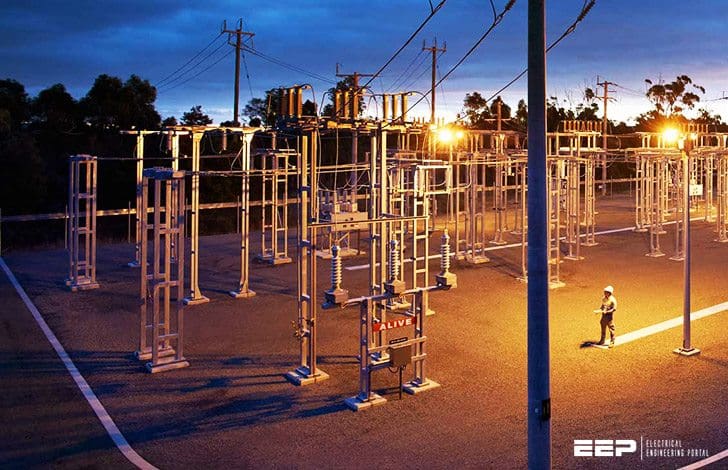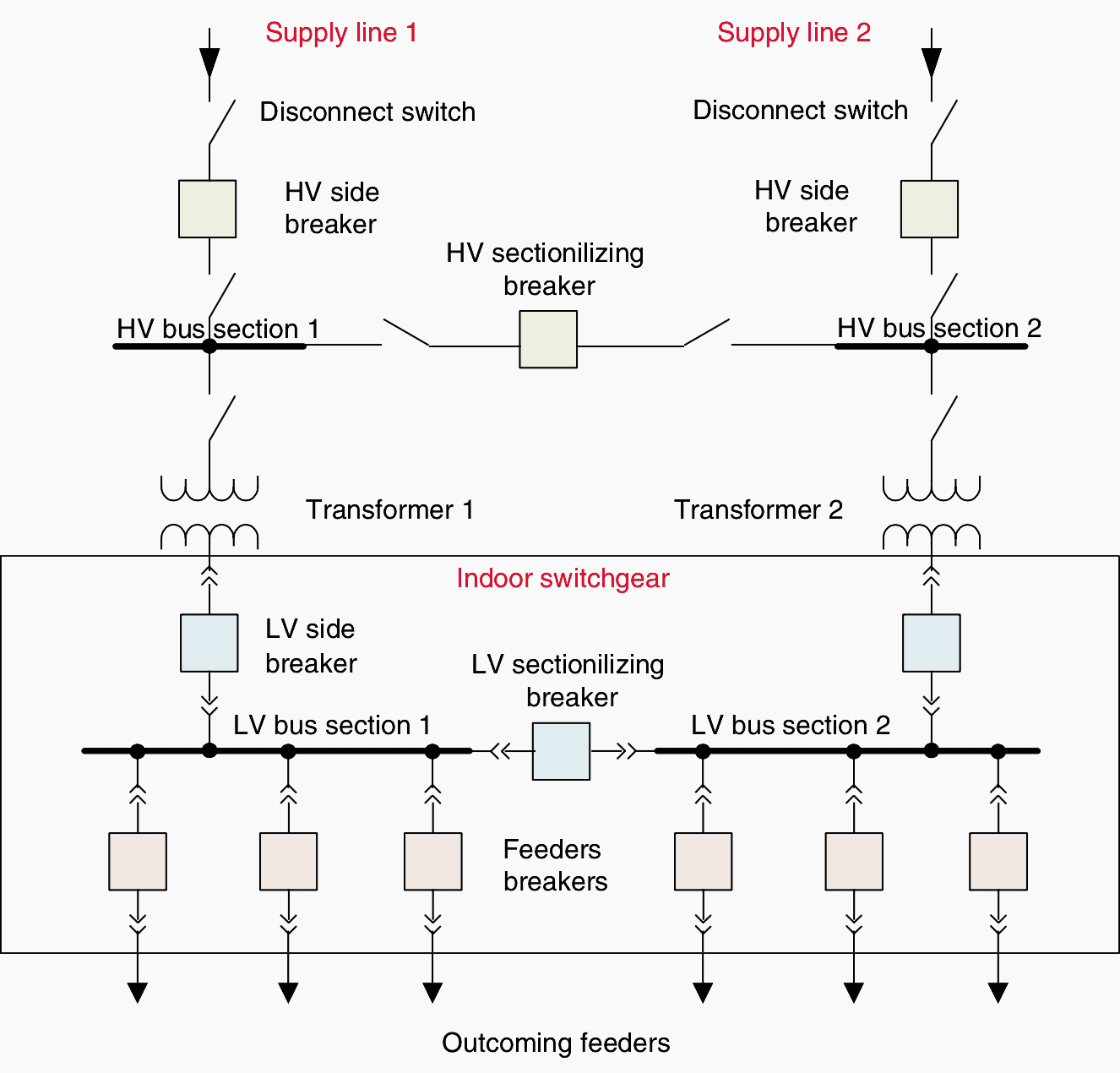Design Recommendations
Distribution substation design must be a combination of reliability and quality of the power supply, safety, economics, maintainability, simplicity of operation, and functionality. Safety of life and preservation of property are the two most important factors in the design of the substation.

Codes must be followed and recommended practices or standards should be followed in the selection and application of material and equipment.
Operating / Design Limits
Following are the operating and design limits that should be considered in order to provide safe working conditions:
- Interrupting devices must be able to function safely and properly under the most severe duty to which they may be exposed.
- Accidental contact with energized conductors should be eliminated by means of enclosing the conductors, installing protective barriers, and interlocking.
- The substation should be designed so that maintenance work on circuits and equipment can be accomplished with these circuits and equipment de-energized and grounded.
- Warning signs should be installed on electric equipment accessible to both qualified and unqualified personnel, on fences surrounding electric equipment, on access doors to electrical rooms, and on conduits or cables above 600 V in areas that include other equipment.
- An adequate grounding system must be installed.
- Emergency lights should be provided where necessary to protect against sudden lighting failure.
- Operating and maintenance personnel should be provided with complete operating and maintenance instructions, including wiring diagrams, equipment ratings, and protective device settings.
In general, system costs increase with system reliability if component quality is equal. Maximum reliability per unit investment can be achieved by using properly applied and well-designed components.


Figure 1 above provides an example of the distribution substation single line diagram with: two transformers, two supply lines, and two sections at both the high-voltage (HV) side and low-voltage (LV) sides, with sectionalizing breakers at both HV and LV voltages.
If the substation is designed to supply a manufacturing plant, continuity of service may be critical. Some plants can tolerate interruptions while others require the highest degree of service continuity.
The system should always be designed to isolate faults with a minimum disturbance to the system, and should have features to provide the maximum dependability consistent with the plant requirements and justifiable cost.
The majority of power utilities today supply energy to medium and large industrial customers directly at 34.5, 69, 115, 138, 161, and 230 kV using dedicated substations.
Small industrial complexes may receive power at voltages as low as 4 kV.
Poor voltage regulation is harmful to the life and operation of electrical equipment. Voltage at the utilization equipment must be maintained within equipment tolerance limits under all load conditions, or equipment must be selected to operate safely and efficiently within the voltage limits.
Load-flow studies and motor-starting calculations are used to verify voltage regulation.
Substation Physical Appearance
It is desirable to locate distribution substations as near as possible to the load center of its service area, though this requirement is often difficult to satisfy. Locations that are perfect from engineering and cost points of view are sometimes prohibited due to physical, electrical, neighboring, or aesthetic considerations.
Better Solution – However, an aboveground design requires overhead sub-transmission line structures (Figure 2), which are often undesirable structures for neighborhoods. Therefore, incoming lines are often underground cables, and the entire substation is designed to be as unobtrusive as possible.
Underground cables are more costly than overhead lines for the same voltage and capacity. Installation of underground cables in urban areas is also often inconvenient and potentially hazardous.
Local conditions or system-wide policy may require landscaping at a substation site or for housing the substation within a building.
A fence with warning signs or other protective enclosures is typically provided to keep unauthorized persons from coming in close proximity of the high-voltage lines and substation equipment. Alarm systems and video surveillance are becoming normal practices for monitoring and preventing intrusion by unauthorized persons.
Substation Standardization
Standards, recommended practices, and guides are used extensively in communicating requirements for design, installation, operation, and maintenance of substations.
Recommended practices suggest methods of accomplishing an objective for specific conditions. Guides specify the factors that should be considered in accomplishing a specific objective. All are grouped together as standards documents.
Standards are used to establish a small number agreed to by the substation community of alternative solutions from a range of possible solutions. This allows purchasers to select a specific standard solution knowing that multiple vendors will be prepared to supply that standard, and that different vendor’s produces will be able to inter-operate with each other.
Conversely, this allows vendors to prepare a small number of solutions knowing that a large number of customers will be specifying those solutions. Expensive and trouble-prone custom “one-of-a-kind” design and manufacturing can be avoided.
Considerable experience and expertise goes into the creation and maintenance of standards, providing a high degree of confidence that solutions implemented according to a standard will perform as expected.
Standards also allow purchasers to concisely and comprehensively state their requirements, and allow vendors to concisely and comprehensively state their products’ performance.
There are several bodies publishing standards relevant to substations. Representative of these are the following:
IEEE
Description – The Institute of Electrical and Electronics Engineers (IEEE) is a nonprofit, transnational professional association having 38 societies, of which the Power and Energy Society (PES) is “involved in the planning, research, development, construction, installation, and operation of equipment and systems for the safe, reliable, and economic generation, transmission, distribution, measurement, and control of electric energy.”
For more information, visit www.ieee-pes.org.
NEMA
Description – The National Electrical Manufacturers Association (NEMA) is a trade association of the electrical manufacturing industry that manufactures products used in the generation, transmission and distribution, control, and end-use of electricity.
NEMA provides a forum for the development of technical standards that are in the best interests of the industry and users; advocacy of industry policies on legislative and regulatory matters; and collection, analysis, and dissemination of industry data.
For more information, visit www.nema.org.
ANSI
Description – American National Standards Institute (ANSI) oversees the creation, promulgation, and use of thousands of norms and guidelines that directly impact businesses in nearly every sector, including energy distribution.
ANSI is also actively engaged in accrediting programs that assess conformance to standards – including globally recognized cross-sector programs such as the ISO 9000 (quality) and ISO 14000 (environmental) management systems.
For more information, see www.ansi.org.
NFPA
Description – National Fire Protection Association (NFPA) is an international nonprofit organization established in 1896 to reduce the worldwide burden of fire and other hazards on the quality of life by providing and advocating consensus codes and standards, research, training, and education.
NFPA develops, publishes, and disseminates more than 300 consensus codes and standards intended to minimize the possibility and effects of fire and other risks. Of particular interest to substations is the National Electrical Code (NEC).
For more information, see www.nfpa.org.
IEC
Description – International Electrotechnical Commission (IEC) technical committee is an organization for the preparation and publication of International Standards for all electrical, electronic, and related technologies. These are known collectively as “electrotechnology.”
Every member country, no matter how large or small, has one vote and a say in what goes into an IEC International Standard.
For more information, see www.iec.ch.
ISO
Description – International Organization for Standardization (ISO) is a nongovernmental organi- zation that forms a bridge between the public and private sectors.
Many of its member institutes are part of the governmental structure of their countries, or are mandated by their government while other members have their roots uniquely in the private sector, having been set up by national partnerships of industry associations.
ISO enables a consensus to be reached on solutions that meet both the requirements of business and the broader needs of society.
For more information, see www.iso.org.
ITU
Description – International Telecommunication Union (ITU) is the United Nations’ agency for information and communication technology issues, and the global focal point for governments and the private sector in developing networks and services.
For more information, see www.iut.int.
Reference // Distribution Systems, Substations, and Integration of Distributed Generation by John D. McDonald, Bartosz Wojszczyk, Byron Flynn, and Ilia Voloh











I really appreciate all of members that are shared best articles in electrical.
I really like this site because it gives very good articles
i love to explore more in electrical engineering
Quite informative!